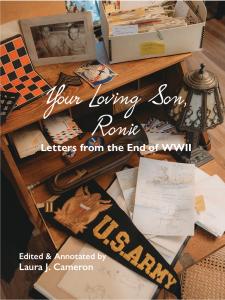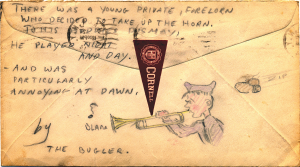New Book Out for Veterans Day Recounts WWII Stories of Young Soldier and the Home Front Through 424 Lively Letters
This illustrated, annotated collection of long-lost letters captures voices from waning years of Second World War, marking 80th anniversary after war's end.
An only child, I grew up immersed in my father's tales of wartime service. Finding the letters revealed not only his clever cartoons, but also how much he disguised troubles on the Home Front.”
OLYMPIA, WA, UNITED STATES, November 4, 2025 /EINPresswire.com/ -- The voices of World War II are almost completely silent 80 years after the war's official end in September 1945. But in this new annotated collection of long-lost letters, written between March 1944 and July 1946, we hear the distinctive voice of one young soldier, Corporal Ronald Francis Dick, ring out clearly — by turns exuberant, bored, determined, even philosophical.— Laura J. Cameron
That soldier’s daughter, Laura J. Cameron, wrote “Your Loving Son, Ronie: Letters from the End of WWII” to capture the authentic voices of family members during the Second World War. This full-color book has succeeded in bringing a unique and personal perspective on the war’s effect on soldiers as well as their families.
The 424 letters trace young Ronie’s path by troop train to US Army Air Force technical schools in five states, until his eventual deployment across the Pacific delivers unimaginable culture-shock in “the land of mystery,” India. The letters then tell of American and RAF pilots shuttling “over the Hump” of the Himalayas in between his lively narratives that sound just like a newsreel:
“See: Jeweled images just like the ones Hollywood tries to imitate. Beggars and rajahs, a cross section of India... listen in to our broadcast of the Adventures of Ronald 'Ripley' Dick!”
With the letters are a collage of Ronie’s cartoons and snapshots, plus postcards and ephemera of the day. Ronald draws himself on a snowy midnight dash to the latrine at Truax Field near Madison, Wisconsin, while colorful postcards mark his first studies at Cornell University in Ithaca, New York. His illustration of bugle practice is accompanied by a limerick and a Herrimanesque boot flung by an unseen buddy:
“There was a young private forlorn, Who decided to take up the horn.
To his buddies’ dismay, He played night and day, And was particularly annoying at dawn.”
The snapshots of his airbase in India, outside what was then called Dacca in West Bengal, include aircraft, the radio shack, “basha boys,” and himself serving “chow” to the puppies of Bessie, the base’s half-jackal mascot.
Buddies, parents, sisters: Everyone wrote letters in wartime
The letters represent two years, from March 1944 through June 1946, when all America was caught up in the tumultuous, turning-point years of World War II. Young Ronie, only 17 when he enlisted, found himself swiftly separated from friends and kin by many miles — eventually half the globe. Writing letters to bridge that gap was considered a patriotic duty.
Cameron was surprised at the number of surviving postcards and letters from her father’s school friends from Queens, New York, and his Army buddies. The latter often describe their own woes: “Quick, get Stanley or Livingstone to form a safari, am lost in Florida’s great everglades. No beer, no women, only sand, bugs and detail.” My, how Boca Raton has changed…
Ronald also sent home a diverse array of souvenirs, from a pamphlet issued by the Denver, Colorado, Convention and Visitors Bureau offering the city’s “sincere and open-hearted hospitality to every Service Man and Woman,” to flattened zinc pennies and rare “money” issued by the “Bank of Independent Jai Hind and Pakisthan.” The most remarkable survival, carefully preserved for more than 80 years, is a leaf from Fremantle, Western Australia, inscribed with the date: July 19, 1945.
Bill Mauldin, the G.I. cartoonist who created the bedraggled characters Joe and Willie, two infantry dogfaces who represented the Everyman fighting at the front, understood the precious nature of letters very well. Mauldin drew one cartoon every homesick soldier would recognize, in which three sorrowful doggies stand by an Army mail Jeep that’s evidently taken a hit — its frame crumpled and smoking, letters strewn across the road. The driver, equally battered, asks one, “Why ya lookin’ so sad? I got out of it okay.” Mauldin wrote about this cartoon, “The mail is by far the most important reading matter that reaches soldiers overseas. … A soldier’s life revolves around his mail.”
A gift from the past
The book was a labor of love for Cameron, spanning the decade since her father’s death as she uncovered more and more dusty shoeboxes of letters and his souvenirs. As she pieced together his story, and the stories of those left behind, the 580-page book evolved to incorporate five appendices of background information. Cameron offers hundreds of quick explanations for military slang; movie, book and radio show references; and the challenges facing those on the Home Front, from gasoline rationing to rabbits marauding the Victory Garden.
Together, they offer readers an intriguing walk through the culture and experiences of the Greatest Generation. Fittingly for its November release, the book is a tribute to all veterans and their families, and a reminder of the enduring impact of war on individuals and society.
This delightful and substantial book will appeal to everyone who loves first person accounts of daily life in times past, as well as scholars seeking new primary source material from 1944-1946.
For more information or to purchase "Your Loving Son, Ronie: Letters from the End of WWII," please visit www.artforartssakepress.com or contact Laura Cameron at laura@artforartssakepress.com or 360-628-7176.
Laura Jean Cameron
Laura J. Cameron / Art for Art's Sake Press
+1 360-628-7176
email us here
Your Loving Son book trailer
Legal Disclaimer:
EIN Presswire provides this news content "as is" without warranty of any kind. We do not accept any responsibility or liability for the accuracy, content, images, videos, licenses, completeness, legality, or reliability of the information contained in this article. If you have any complaints or copyright issues related to this article, kindly contact the author above.



